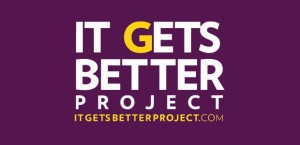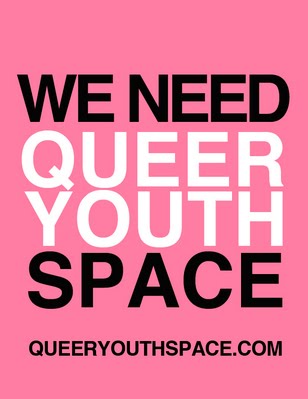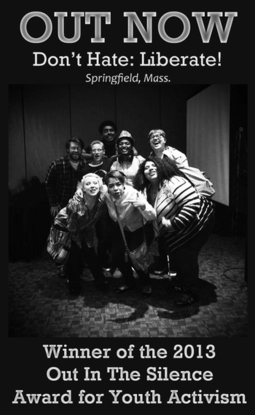(Part of the Hot Spot series “By Any Media Necessary”)
By Raffi Sarkissian
(@rsark)
Queer visibility in the media has come a long way. LGBT rights awareness and activism also seems to be on a fluctuating but steady climb to increasing education, acceptance, and inclusion. While much of these changes can be attributed to an increasingly connected and networked world online, the work being done to bring communities together is also paralleled by the local activism, offline spaces, and lived experiences and circumstances of LGBTQ lives, particularly queer youth.
LGBT and queer-identified individuals have a strong history with the web. Usually among the first to jump on new media and technology, sexual minorities gravitate toward safe and discreet spaces for communication. During times of minimal to invisible media exposure, when the risks of being out in one’s offline world were too high, particularly for queer youth, the web offered those with access a means to connect, to come out, to create, to congregate, and even organize for social and political activism.[1]
While message boards, online journals, social media, and YouTube had become vital spaces for queer youth to assert their voice, it wasn’t until a string of gay teen suicides in September 2010 made national headlines that the lives of queer youth suddenly became more visible and more vulnerable. Due to the reactionary It Gets Better Project, there was a heightened focus on the well-being of at-risk queer youth and some concerted efforts to address the issues of bullying and institutional homophobia.  Yet, much of this discourse did not involve queer youth. In fact, among the critiques of the It Gets Better Project was that youth voices were invoked but largely invisible, especially in the videos that gained the most mainstream media traction (celebrities, politicians, and corporations all “speaking to” queer youth). These well-intentioned messages of hope nonetheless implicated a gap – between relating to being a queer or ostracized teen and offering themselves as proof that it gets better. As many quickly took the project to task, questions surfaced about the now, about current circumstances of queer youth, about education, change, and activism. Where were the voices of queer youth?[2]
Yet, much of this discourse did not involve queer youth. In fact, among the critiques of the It Gets Better Project was that youth voices were invoked but largely invisible, especially in the videos that gained the most mainstream media traction (celebrities, politicians, and corporations all “speaking to” queer youth). These well-intentioned messages of hope nonetheless implicated a gap – between relating to being a queer or ostracized teen and offering themselves as proof that it gets better. As many quickly took the project to task, questions surfaced about the now, about current circumstances of queer youth, about education, change, and activism. Where were the voices of queer youth?[2]
Whereas the affordances of online resources and community play a vital role in issues pertaining to queer youth voice and advocacy, my preliminary research has revealed that the local and offline worlds are still places where queer youth are doing a great deal of organizing. Some of these mobilized groups use media and technology as tools (not goals) among their other resources to bring about change and affect the condition of queer lives on the ground. For the remainder of this post, I want to highlight a few of these queer youth-led local organizations that are doing grassroots mobilizing and open a conversation about varying uses of media and communication. Finally, I will come back to It Gets Better and the work of its offshoot project It Gets Better Tour, which is now a traveling stage show, reaching out and engaging with queer youth in local cities across the country.
Queer Youth Space
 Highlighting the challenges of finding safe local queer spaces that are not bars or clubs (inaccessible to under 18 and 21 youth), Queer Youth Space (QYS) emerged as a goal, a community, and an ideal when hundreds of youth in Seattle, Washington came together in 2010 to address the issues and needs of queer youth. After two years of searching, QYS found and claimed their spot at 911 E. Pike Street, Capital Hill in Seattle.[3] Their mission, however, was never confined to physical boundaries. While not a medium in the traditional audiovisual sense, space operates here as both a place and an idea and is constitutive of and constituted in expression and activism. As expressed on the group’s facebook page:
Highlighting the challenges of finding safe local queer spaces that are not bars or clubs (inaccessible to under 18 and 21 youth), Queer Youth Space (QYS) emerged as a goal, a community, and an ideal when hundreds of youth in Seattle, Washington came together in 2010 to address the issues and needs of queer youth. After two years of searching, QYS found and claimed their spot at 911 E. Pike Street, Capital Hill in Seattle.[3] Their mission, however, was never confined to physical boundaries. While not a medium in the traditional audiovisual sense, space operates here as both a place and an idea and is constitutive of and constituted in expression and activism. As expressed on the group’s facebook page:
“This project is now and will forever be a rebellion, an uprising, a mutiny… As “queer” exists beyond all boundaries, so do we. Our pace is a kind of space that lies not so much within narrow physical confines, such as a building or a room, but rather wherever and whenever we claim space for ourselves and for the people around us. It follows us wherever we go, it manifests itself wherever we are.”
While the need for an actual physical space for coming together is self-evident in the group’s activities over the years, the above statement reveals that for this group of teens, space operates beyond the physical – and beyond the virtual for that matter – and is taken up, much like the feminist credo, “the personal is political,” when and where queers assert themselves.
Out Now
 According to their website, Out Now originated in 1995 – well before the prominence of web 2.0 and political organizing online – as a weekly support group for LGBT youth from the larger Springfield, MA area. Since then, Out Now has grown into a non-profit with an advisory board, staff, and a growing list of campaigns and programs aimed at the local community. Among their activities, Out Now hosts a weekly poetry/spoken word workshop (Breathing Fire, Spitting Verse) for youth (under 22 years of age) that seeks to “empower LGBTQA to harness the power of words and the power of their own voices to engage with their experiences, to heal, to define and reclaim their identities, thus speaking themselves into existence.” Much like space in the previous group, voice and speech here are the operative tools used to assert their identities, a sense of queer activism for many youth. Out Now also puts on “Our Liberation!,” an interactive performance workshop that utilizes Theater of the Oppressed techniques that engage both actors and spectators working together to find ways of combating realities of peer abuse, violence, and harassment.
According to their website, Out Now originated in 1995 – well before the prominence of web 2.0 and political organizing online – as a weekly support group for LGBT youth from the larger Springfield, MA area. Since then, Out Now has grown into a non-profit with an advisory board, staff, and a growing list of campaigns and programs aimed at the local community. Among their activities, Out Now hosts a weekly poetry/spoken word workshop (Breathing Fire, Spitting Verse) for youth (under 22 years of age) that seeks to “empower LGBTQA to harness the power of words and the power of their own voices to engage with their experiences, to heal, to define and reclaim their identities, thus speaking themselves into existence.” Much like space in the previous group, voice and speech here are the operative tools used to assert their identities, a sense of queer activism for many youth. Out Now also puts on “Our Liberation!,” an interactive performance workshop that utilizes Theater of the Oppressed techniques that engage both actors and spectators working together to find ways of combating realities of peer abuse, violence, and harassment.
BreakOUT
BreakOUT is a New Orleans-based youth organization focused on ending the criminalization of lesbian, gay, bisexual, transgender, and questioning youth in an effort to establish safety and justice in New Orleans. They use a combination of offline and online social media tactics to counter discrimination, particularly NOPD’s abusive treatment of queer youth of color. On-the-ground efforts include community education training and campaigns (#KnowYourRights), building coalition through attending conferences, and mobilizing with allied organizations and campaigns (such as Congress of Day Laborers andOrleans Parish Prison Reform Coalition). They also use online and social media outlets to spread knowledge and bring focused attention to the problems facing queer youth in New Orleans. Check out their video for the “We Deserve Better” campaigns below and their successful campaign to bring actress (Orange is the New Black) and transgender activist Laverne Fox for a visit.
It Gets Better Tour
Finally, I want to come back to the It Gets Better Tour, a collaborative project put together by the Gay Men’s Chorus of Los Angeles, Speak Theater Arts, and It Gets Better. This incarnation takes ideas, themes, and responses to the online video phenomenon and incorporates them into a traveling stage show and community outreach program with stops in cities from Ogden, Utah to Houston, Texas, Whitewater, Wisconsin and many more. Written and directed by Liesel Reinhart, the It Gets Better Tour blends music, theater, and multimedia for an original production that addresses issues related to the lives and experiences of queer youth. In addition to the performance, each tour stop includes several days of meeting and workshopping with the local community, high schools, and colleges, engaging with and learning from youth. While this project was not conceived and implemented by youth, it is worth noting that the tour is certainly a step towards building dialogue and coalition between adults and youth by moving beyond distant messages of hope and engaging with youth at the local level. The end-product of these stops yet again reveal the power inherent in mobilized and empowered youth (like collaborating with Lawrence, Kansas middle school kids to produce this PSA). Check out a full log of their first tour stop in Iowa City, Iowa here.
The unifying medium for this iteration of the It Gets Better Project is undeniably its incorporation of music and performance. Song resonates affectively and becomes a way not only to speak to but more importantly work with youth. Like space, voice, and more strategic organizing, it becomes yet but another form of media that is used for outreach, community, and social and political action. Media here is not invoked as the traditional mass communication channels we more often associate it with, but a means for communication nonetheless. The brief cases provided in this post have not been aimed at diminishing the role and uses of traditional or online media as ways to affect change, but trying to broaden the scope of the tools at our disposal, and more particularly, the ways queer youth are participating in social and political activism. As these cases reveal, queer youth are not silent and are not passive; often they are proactive. Just because all their efforts don’t live online does not mean they are invisible. These groups demonstrate that the web and technology are among the many tools at their disposal to organize, mobilize, or simply assert their identities.
I urge readers to add, expand, and complicate this post by sharing (in the comments below) more ways queer youth are using media to assert their identities, to build communities, to combat violence and discrimination, and to affect change.
Footnotes
[1] For more on queer users’ uptake of web resources and technology, check out Larry Gross’s article, “Gideon Who Will be 25 in the Year 2012: Growing Up Gay Today” in the International Journal of Communication (2007) ; also check out Christopher Pullen and Margaret Cooper’s edited volume on LGBT Identity and Online New Media for a variety of chapters on LGBT uses of the Internet and Youtube (Routledge: New York, 2010).
[2] This is not to say that there weren’t queer youth who were engaged and active in these issues. In addition to cases in the post, youth-led campaigns like Make It Better and Reteaching Gender and Sexuality offered some albeit less visible counter-balance to the apparent absence of queer youth voices in the mainstream media. And, of course, GSA Network has long been a vital resource for connecting and empowering queer youth in California and increasingly across the nation.
[3] As of March 2014, the facebook page for QYS revealed that they will be moving out of their current space and on the search for another.



Speak Your Mind